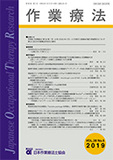Japanese
English
- 販売していません
- Abstract 文献概要
- 1ページ目 Look Inside
- 参考文献 Reference
- サイト内被引用 Cited by
要旨:回復期の脳卒中後上肢片麻痺者に対し,15日間のロボット療法の効果検証を行った.対象は,2015年6月から2018年8月の期間に当院に入院した,初発の脳卒中後上肢片麻痺者のうち,15日間のロボット療法を実施した群(介入群)と,1ヵ月間の通常訓練を実施した群(対照群)とした.方法は,介入群と対照群で傾向スコアマッチングを実施し,Fugl-Meyer Assessment(以下,FMA)肩・肘・前腕の変化量を比較した.結果は,介入群36名,対照群62名で,22ペアがマッチングされた.FMA肩・肘・前腕の変化量は,介入群が対照群に比べ有意に改善を示した.ロボット療法を用いた介入は,効率的に回復期の脳卒中患者の上肢機能を改善させる可能性がある.
Background: We investigated the improvement of affected upper-extremity function in stroke patients in the subacute phase who received robotic therapy for 15 days. Participants: 36 subjects who received the robotic therapy for 15 days (the intervention group), and 62 subjects who received standard rehabilitation for one month (the control group) from June 2015 to August 2018. Method: We compared the proximal upper-extremity scores of Fugl-Meyer Assessment (FMA) using propensity score matching of the intervention group and control group. Results: 44 patients in both groups were matched by propensity score matching. Consequently, the proximal upper-extremity score of Fugl-Meyer Assessment (FMA) in the intervention group improved significantly more than the control group. Conclusion: Intervention using robotic therapy might efficiently improve the affected upper-extremity deficits for subacute stroke patients.

Copyright © 2019, Japanese Association of Occupational Therapists. All rights reserved.


